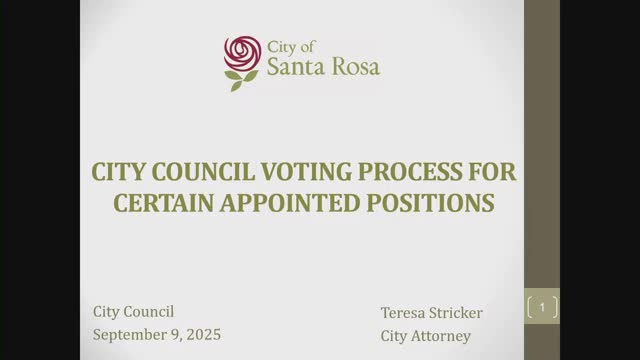City Council Considers Simplifying Appointment Processes and Introducing Ranked Choice Voting
September 10, 2025 | Santa Rosa City, Sonoma County, California
This article was created by AI summarizing key points discussed. AI makes mistakes, so for full details and context, please refer to the video of the full meeting. Please report any errors so we can fix them. Report an error »

In the heart of Santa Rosa's city hall, council members gathered on September 9, 2025, to address pressing governance issues, particularly the procedures for filling council vacancies and appointing members to various boards and commissions. As the meeting unfolded, the complexities of the current appointment processes came to light, revealing a need for clarity and efficiency.
City Attorney Theresa Benuelos presented a detailed overview of the existing rules governing council appointments. Under the city charter, when a vacancy arises, the council faces a choice: call a special election or appoint a replacement. However, if the council opts for an appointment and fails to reach a consensus within 60 days, a special election must be held—a costly endeavor that many council members are keen to avoid.
Benuelos highlighted the challenges inherent in the current appointment process, particularly the lack of clear rules for resolving deadlocks. For instance, when appointing members to boards and commissions, the council can either vote by motion or through a process of elimination. Yet, if the votes result in a tie, the council is left without a defined method to break the stalemate, often leading to confusion and frustration.
To streamline these processes, Benuelos proposed a unified approach for all appointment scenarios. Her recommendation included adopting a consistent method for handling nominations, whether there is one nominee or multiple candidates. In cases of ties, she suggested using random selection as a last resort, a method humorously referred to as the "Uncle Sam hat" approach.
The discussion also touched on the selection of the mayor and vice mayor, positions that rotate every two years and one year, respectively. Benuelos emphasized the need for a clear process to avoid the pitfalls of indecision, particularly in situations where council members may be absent or when a seat is vacant.
Council members engaged in a lively dialogue about the proposed changes, weighing the merits of ranked-choice voting against traditional elimination methods. Some expressed concerns about the complexity of implementing ranked-choice voting, especially for larger boards with multiple candidates. Others suggested exploring a rotation system for the mayor and vice mayor positions to minimize conflicts and enhance fairness.
As the meeting progressed, public comments echoed the council's deliberations. Residents voiced their concerns about maintaining transparency and public participation in the appointment process, emphasizing the importance of preserving the democratic nature of city governance.
In conclusion, the Santa Rosa City Council's meeting illuminated the intricacies of local governance and the pressing need for reform in appointment procedures. As the council considers Benuelos's recommendations, the path forward remains uncertain, but the commitment to enhancing clarity and efficiency in city operations is clear. The council's next steps will be crucial in shaping the future of governance in Santa Rosa, ensuring that it remains responsive to the needs of its community.
City Attorney Theresa Benuelos presented a detailed overview of the existing rules governing council appointments. Under the city charter, when a vacancy arises, the council faces a choice: call a special election or appoint a replacement. However, if the council opts for an appointment and fails to reach a consensus within 60 days, a special election must be held—a costly endeavor that many council members are keen to avoid.
Benuelos highlighted the challenges inherent in the current appointment process, particularly the lack of clear rules for resolving deadlocks. For instance, when appointing members to boards and commissions, the council can either vote by motion or through a process of elimination. Yet, if the votes result in a tie, the council is left without a defined method to break the stalemate, often leading to confusion and frustration.
To streamline these processes, Benuelos proposed a unified approach for all appointment scenarios. Her recommendation included adopting a consistent method for handling nominations, whether there is one nominee or multiple candidates. In cases of ties, she suggested using random selection as a last resort, a method humorously referred to as the "Uncle Sam hat" approach.
The discussion also touched on the selection of the mayor and vice mayor, positions that rotate every two years and one year, respectively. Benuelos emphasized the need for a clear process to avoid the pitfalls of indecision, particularly in situations where council members may be absent or when a seat is vacant.
Council members engaged in a lively dialogue about the proposed changes, weighing the merits of ranked-choice voting against traditional elimination methods. Some expressed concerns about the complexity of implementing ranked-choice voting, especially for larger boards with multiple candidates. Others suggested exploring a rotation system for the mayor and vice mayor positions to minimize conflicts and enhance fairness.
As the meeting progressed, public comments echoed the council's deliberations. Residents voiced their concerns about maintaining transparency and public participation in the appointment process, emphasizing the importance of preserving the democratic nature of city governance.
In conclusion, the Santa Rosa City Council's meeting illuminated the intricacies of local governance and the pressing need for reform in appointment procedures. As the council considers Benuelos's recommendations, the path forward remains uncertain, but the commitment to enhancing clarity and efficiency in city operations is clear. The council's next steps will be crucial in shaping the future of governance in Santa Rosa, ensuring that it remains responsive to the needs of its community.
View full meeting
This article is based on a recent meeting—watch the full video and explore the complete transcript for deeper insights into the discussion.
View full meeting
